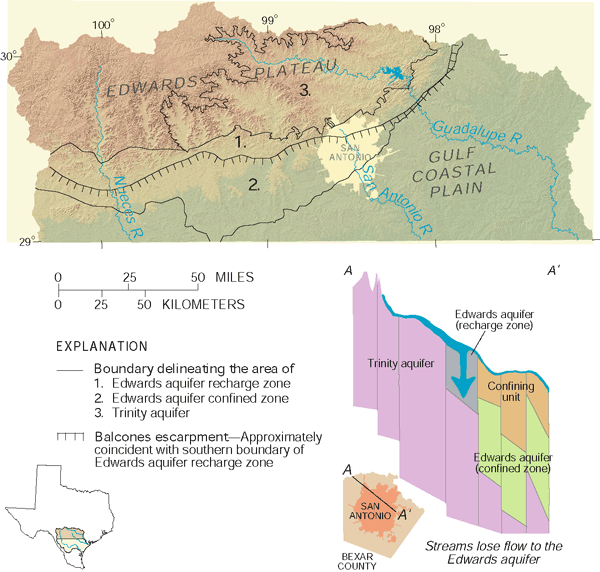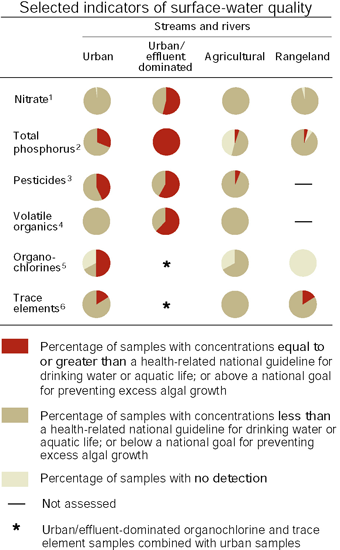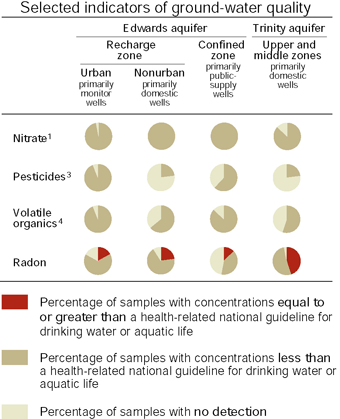SUMMARY OF MAJOR FINDINGS
 |
| The South-Central Texas Study Unit encompasses the Nueces, San Antonio, and Guadalupe River Basins. The 1996–98 assessment involved only the upper part of the Study Unit. Streams and rivers that originate in the rugged hills of the Edwards Plateau generally gain water as they flow southeastward toward the Edwards aquifer outcrop (recharge zone). As they flow across the highly permeable, faulted, and fractured rocks of the recharge zone, most lose substantial amounts of flow directly into the aquifer. |
Stream and River Highlights
Numerous organic chemicals and trace elements were detected in streams and rivers in the upper part of the South-Central Texas Study Unit—in part because of high detection sensitivities (fractions of a part per billion) of laboratory analytical methods. Most concentrations of organic chemicals and trace elements were extremely low and many times less than levels of concern for human health or aquatic life. No concentrations of sampled chemical constituents except those of dissolved nitrite plus nitrate nitrogen (hereinafter, nitrate) downstream from wastewater treatment plants exceeded drinking-water standards or guidelines. Although surface water historically has not been a source of drinking water, streams and rivers are the major source of replenishment (recharge) to the Edwards aquifer, the principal water supply for much of the region. Surface water provides habitat for a wide variety of aquatic organisms and recreational opportunities for many people.
- Nitrate concentrations downstream from wastewater treatment plants consistently were about 5 times greater than those downstream from agricultural land and about 20 times greater than those downstream from rangeland. All total phosphorus concentrations downstream from wastewater treatment plants exceeded a goal for controlling nuisance algae and aquatic plant growth.
- More pesticides and volatile organic compounds (VOC) at generally higher concentrations were detected in urban stream water than in agricultural stream water. Concentrations of each of six pesticides and one VOC exceeded aquatic-life guidelines in several (mostly urban) stream samples. The herbicide atrazine was detected in all urban and agricultural stream samples.
- Generally higher concentrations of organochlorine compounds and trace elements were detected in urban stream-sediment and fish-tissue samples than in agricultural and rangeland samples. Concentrations of several samples exceeded sediment guidelines for the protection of aquatic life or fish-tissue guidelines for the protection of fish-eating wildlife; most were from urban streams.
- Biological community status is related to watershed development. The most degraded algal, invertebrate, and fish communities were in urban streams, and the healthiest were in rangeland streams.
 |
| 1Nitrate (as nitrogen), sampled
in water. |
| Major Influences on Streams and Rivers
|
Ground-Water Highlights
Ground water, primarily from the Edwards aquifer and also from the Trinity aquifer, is the principal source of water supply in the upper part of the Study Unit. In general, the quality of water in the Edwards and Trinity aquifers reflects little evidence of human activities—despite major urban development and agricultural land in places overlying the Edwards aquifer and increasing urban development in places overlying the Trinity aquifer. Numerous organic chemicals were detected in the Edwards aquifer, fewer in the Trinity aquifer, but most concentrations were extremely low. Concentrations of nutrients, organic chemicals, and trace elements generally were very low relative to drinking-water standards and guidelines. Some radon concentrations exceeded a proposed drinking-water standard, but radon concentrations were among the lowest of NAWQA Study Units nationwide.
- The median nitrate concentration among primarily public-supply wells sampled in the confined zone of the Edwards aquifer was about six times less than the maximum contaminant level for nitrate in drinking water; nevertheless, the median was in the top 10 percent of median nitrate concentrations of major aquifers sampled by NAWQA nationwide. Median nitrate concentration in the Trinity aquifer was more than 10 times less than that in the Edwards aquifer.
- The greatest frequencies of detection of pesticides and VOCs in the Edwards aquifer were in urban (northern San Antonio) recharge-zone samples. The outcropping fractured and faulted limestone of the recharge zone allows unrestricted downward movement of water, which can contain contaminants, into the ground-water-flow system.
- Four of the 5 most frequently detected pesticides in water from urban recharge-zone wells in the Edwards aquifer were the same as 4 of the 5 most frequently detected pesticides in surface water at urban sites in the San Antonio area. This finding illustrates the correlation between the quality of recently recharged ground water in an urban setting and the quality of urban stream and river water.
- The quality of water in the Trinity aquifer remains influenced primarily by the natural processes of water-rock interaction. Concentrations of dissolved solids, sulfate, iron, and strontium exceeded drinking-water standards or guidelines in some samples. Fewer pesticides and VOCs were detected in Trinity aquifer samples than in Edwards aquifer samples, possibly because of low permeability of the Trinity aquifer and little urban development.
 |
| 1 Nitrate (as nitrogen), sampled
in water. |
| Major Influences on Ground Water
|
| Table of Contents || Previous Section || Next Section || Glossary U.S. Geological Survey Circular 1212 Suggested citation:
|

